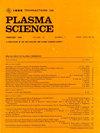Improvement of Multilayer Perceptron Model for Predicting Etch Rates in CF₄ Plasma With Optical Emission Spectrometer and VI Sensor Data
IF 1.3
4区 物理与天体物理
Q3 PHYSICS, FLUIDS & PLASMAS
引用次数: 0
Abstract
We studied a multilayer perceptron model to predict the etch rates of SiO2 and Si3N4 thin films in CF4 plasma using data obtained from a voltage–current (VI) sensor and an optical emission spectrometer (OES). The monitoring data from two devices and etch rate data were collected while varying process parameters such as source power, bias power, and pressure. The data gathered by separately etching a SiO2 coupon or a Si3N4 coupon were determined as training data, and the data gathered by etching both a SiO2 coupon and a Si3N4 coupon simultaneously were determined as test data. We utilized 27 process conditions to obtain training and test data and also employed data augmentation for the training data to improve the learning capability of the model. The multilayer perceptron model trained with data obtained from both the VI sensor and OES showed higher performance in predicting the etch rate of target material in multiple materials than other regression models trained with only data acquired from the OES. This improvement is attributed to the fact that data obtained from the VI sensor includes the information related to ion flux that is proportional to the etch rate and it is not easily captured by only the OES. These results indicate the potential of combining data obtained from the VI sensor and OES to predict the etch rate of target material in multiple materials.利用光学发射光谱仪和VI传感器数据改进多层感知器模型预测cf4等离子体的蚀刻速率
我们研究了一个多层感知器模型,利用电压-电流(VI)传感器和光学发射光谱仪(OES)获得的数据来预测CF4等离子体中SiO2和Si3N4薄膜的蚀刻速率。在不同的工艺参数(如源功率、偏置功率和压力)下,收集了两个器件的监测数据和蚀刻速率数据。分别刻蚀SiO2和Si3N4片材的数据作为训练数据,同时刻蚀SiO2和Si3N4片材的数据作为测试数据。我们利用27个过程条件获得训练和测试数据,并对训练数据进行数据扩充,提高模型的学习能力。与仅使用OES数据训练的回归模型相比,同时使用VI传感器和OES数据训练的多层感知器模型在预测多种材料中目标材料的蚀刻速率方面表现出更高的性能。这种改进归因于从VI传感器获得的数据包括与蚀刻速率成正比的离子通量相关的信息,并且仅通过OES不易捕获。这些结果表明,结合从VI传感器和OES获得的数据来预测目标材料在多种材料中的蚀刻速率的潜力。
本文章由计算机程序翻译,如有差异,请以英文原文为准。
求助全文
约1分钟内获得全文
求助全文
来源期刊

IEEE Transactions on Plasma Science
物理-物理:流体与等离子体
CiteScore
3.00
自引率
20.00%
发文量
538
审稿时长
3.8 months
期刊介绍:
The scope covers all aspects of the theory and application of plasma science. It includes the following areas: magnetohydrodynamics; thermionics and plasma diodes; basic plasma phenomena; gaseous electronics; microwave/plasma interaction; electron, ion, and plasma sources; space plasmas; intense electron and ion beams; laser-plasma interactions; plasma diagnostics; plasma chemistry and processing; solid-state plasmas; plasma heating; plasma for controlled fusion research; high energy density plasmas; industrial/commercial applications of plasma physics; plasma waves and instabilities; and high power microwave and submillimeter wave generation.
 求助内容:
求助内容: 应助结果提醒方式:
应助结果提醒方式:


